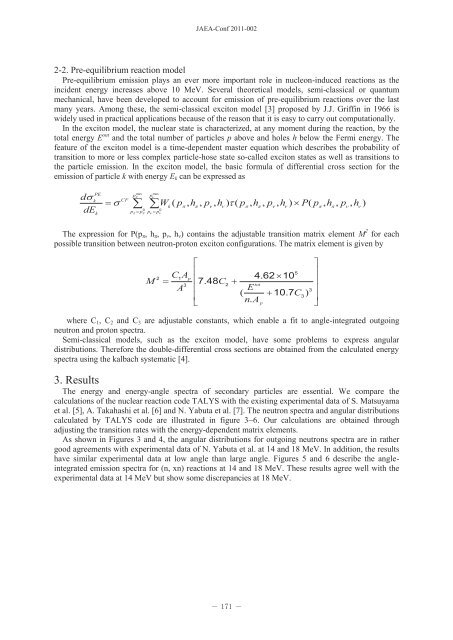JAEA-Conf 2011-002 - 日本原子力研究開発機構
JAEA-Conf 2011-002 - 日本原子力研究開発機構
JAEA-Conf 2011-002 - 日本原子力研究開発機構
Create successful ePaper yourself
Turn your PDF publications into a flip-book with our unique Google optimized e-Paper software.
2-2. Pre-equilibrium reaction model<br />
Pre-equilibrium emission plays an ever more important role in nucleon-induced reactions as the<br />
incident energy increases above 10 MeV. Several theoretical models, semi-classical or quantum<br />
mechanical, have been developed to account for emission of pre-equilibrium reactions over the last<br />
many years. Among these, the semi-classical exciton model [3] proposed by J.J. Griffin in 1966 is<br />
widely used in practical applications because of the reason that it is easy to carry out computationally.<br />
In the exciton model, the nuclear state is characterized, at any moment during the reaction, by the<br />
total energy E out and the total number of particles p above and holes h below the Fermi energy. The<br />
feature of the exciton model is a time-dependent master equation which describes the probability of<br />
transition to more or less complex particle-hose state so-called exciton states as well as transitions to<br />
the particle emission. In the exciton model, the basic formula of differential cross section for the<br />
emission of particle k with energy Ek can be expressed as<br />
PE<br />
max max<br />
p<br />
p<br />
d<br />
k CF<br />
W(<br />
p , h , p , h ) ( p , h , p , h ) P(<br />
p , h , p , h )<br />
k <br />
<br />
dE<br />
0 0<br />
p ppp k<br />
<br />
<br />
<br />
<br />
The expression for P(pπ, hπ, pν, hν) contains the adjustable transition matrix element M 2 for each<br />
possible transition between neutron-proton exciton configurations. The matrix element is given by<br />
M<br />
2<br />
C1A<br />
3<br />
A<br />
p<br />
<strong>JAEA</strong>-<strong>Conf</strong> <strong>2011</strong>-<strong>002</strong><br />
<br />
<br />
7.<br />
48C<br />
<br />
<br />
<br />
2<br />
5<br />
4.<br />
62<br />
10<br />
tot<br />
E<br />
( 10.<br />
7C3)<br />
n.<br />
A<br />
where C1, C2 and C3 are adjustable constants, which enable a fit to angle-integrated outgoing<br />
neutron and proton spectra.<br />
Semi-classical models, such as the exciton model, have some problems to express angular<br />
distributions. Therefore the double-differential cross sections are obtained from the calculated energy<br />
spectra using the kalbach systematic [4].<br />
3. Results<br />
The energy and energy-angle spectra of secondary particles are essential. We compare the<br />
calculations of the nuclear reaction code TALYS with the existing experimental data of S. Matsuyama<br />
et al. [5], A. Takahashi et al. [6] and N. Yabuta et al. [7]. The neutron spectra and angular distributions<br />
calculated by TALYS code are illustrated in figure 3~6. Our calculations are obtained through<br />
adjusting the transition rates with the energy-dependent matrix elements.<br />
As shown in Figures 3 and 4, the angular distributions for outgoing neutrons spectra are in rather<br />
good agreements with experimental data of N. Yabuta et al. at 14 and 18 MeV. In addition, the results<br />
have similar experimental data at low angle than large angle. Figures 5 and 6 describe the angleintegrated<br />
emission spectra for (n, xn) reactions at 14 and 18 MeV. These results agree well with the<br />
experimental data at 14 MeV but show some discrepancies at 18 MeV.<br />
<br />
p<br />
3

















